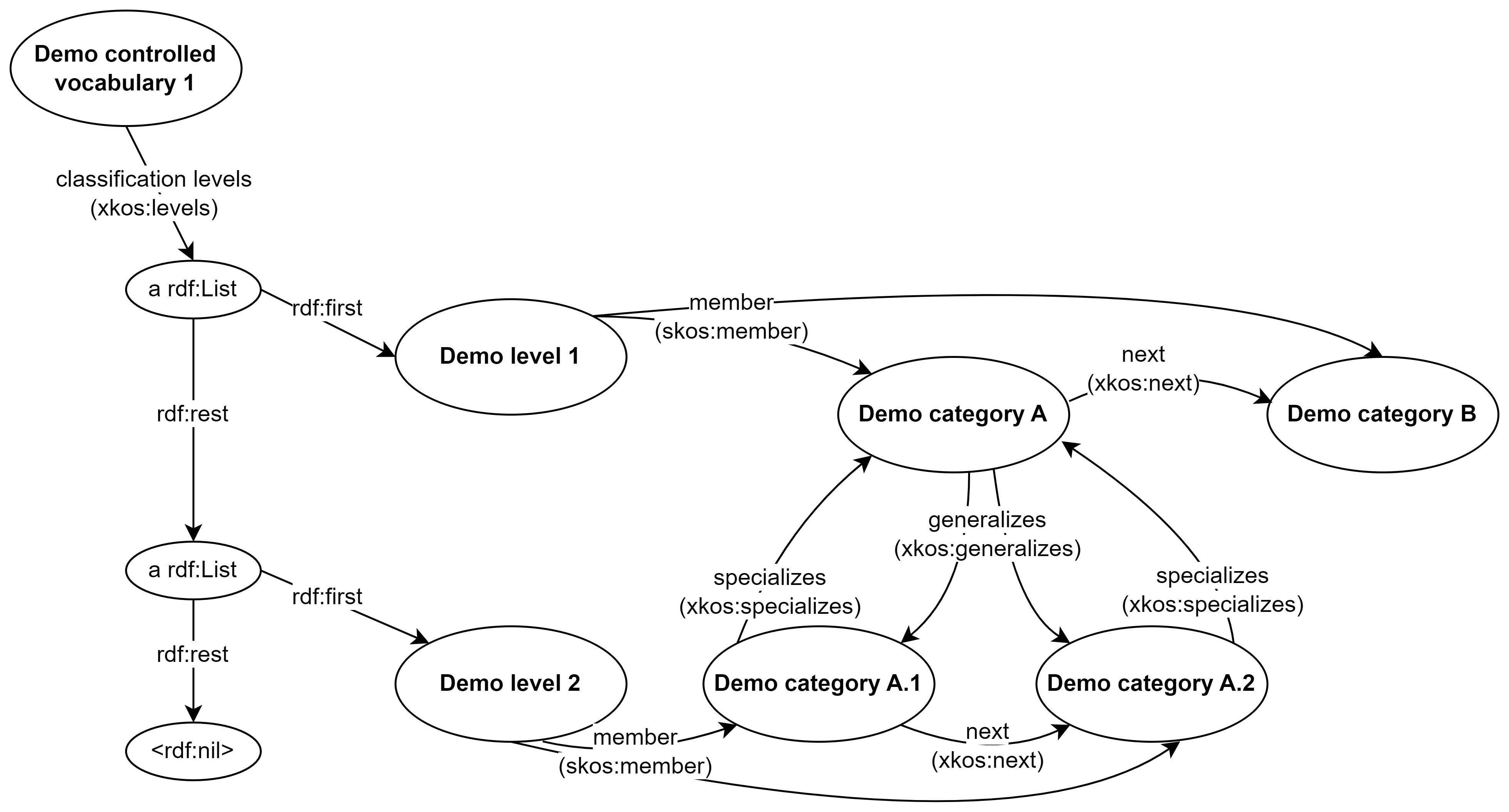Velkommen til utstillingsrommet med demoklassifikasjoner, som demonstrerer bruken av XKOS-AP-NO!
XKOS-AP-NO ⧉ er den norske applikasjonsprofilen av DDI sin XKOS ⧉, for beskrivelse og publisering av klassifikasjoner, kontrollerte vokabularer, kodelister osv.
Tilbakemelding: Vennligst registrer eventuelle tilbakemeldinger som Github Issues ⧉.
Forbehold: Demoressursene tilgjengeliggjort via de enkelte utstillingsrommene er kun ment for demo- og testingsformål.
Resten av teksten er kun på engelsk.
Purpose
This showroom is meant to
-
demonstrate machine-readable descriptions of classifications, classification levels and categories, in accordance with XKOS-AP-NO;
-
demonstrate some cross-references between classifications and other resources demonstrated in some of the other showrooms;
-
provided reusable, machine-readable classifications with referenceable categories, for testing and demonstration purposes.
Disclaimer: The machine-readable demo classifications and demo categories are meant for demo purposes only. They do not represent any real world phenomena. On the other hand, they are supposed to syntactically conform to XKOS-AP-NO.
Demo resources in this showroom
In this showroom we have a demo classification (skos:ConceptScheme) ⧉ with its classification levels (xkos:ClassificationLevel) ⧉ and categories (xkos:ClassificationLevel) ⧉, illustrated in Figur 1.
Our demo classification, called "Demo controlled vocabulary 1", has:
-
two classification levels, "Demo level 1" and "Demo level 2".
-
"Demo level 1" contains categories "Demo category A" and "Demo category B".
-
"Demo level 2" contains "Demo category A.1" and "Demo category A.2".
-
-
"Demo category A" generalizes "Demo category A.1" and "Demo category A.2" .
-
"Demo category A.1" specializes "Demo category A".
-
"Demo category A.2" specializes "Demo category A".
-
-
"Demo category A" should be presented before "Demo category B".
-
"Demo category A.1" should be presented before "Demo category A.2".
Some cross-references with other demo resources
Note: Not all possible cross-references are demonstrated in this showroom. The lists are thus not exhaustive.
Classifications and concepts, for example:
-
A category in a classification is usually a concept. The definition of the concept should preferably be published outside and independently of the classification, although XKOS-AP-NO allows to define the concept as a part of the category description.
-
Our "Demo category A" represents, and thus also refers to, "demo concept 1", using the property concept (dct:subject) ⧉. This is demonstrated in our showroom with demo concepts.
-
Similarly, "Demo category B" represents and refers to "demo concept 2", "Demo category A.1" represents and refers to "demo concept 11", and "Demo category A.2" represents and refers to "demo concept 12".
-
-
A classification and its classification levels usually covers (exhaustively or not, mutually exclusively or not) a set of concepts.
-
Our "Demo level 1", covers (xkos:covers) ⧉, covers exhaustively (xkos:coversExhaustively) ⧉ and mutually exclusively (xkos:coversMutuallyExclusively) ⧉ "demo concept 1" and "demo concept 2". Similarly with our "Demo level 2" and "demo concept 11" and "demo concept 12".
-
-
A concept may refer to a classification as its value range.
-
This is demonstrated in our showroom with demo concepts.
-
Classifications should therefore be made available, also machine-readably.
-
Classifications and datasets, for example:
-
A classification with its categories is a dataset, and should be made available machine-readably.
-
In our showroom with demo datasets, we demonstrate how to describe this demo classification as a machine-readable open dataset, and to make it findable via the demo portal ⧉.
-
-
When describing a dataset, and where coded values are used, the coded values should preferably be chosen from controlled vocabularies (i.e., classifications). Examples of properties with coded values are access rights (dct:accessRights) ⧉ and format (dct:format) ⧉.
-
This is demonstrated and explained in our showroom with demo datasets.
-
Classifications should therefore be made available, also machine-readably.
-
Classifications and information models, for example:
-
When describing an information model, and where coded values are used, the coded values should preferably be chosen from controlled vocabularies (i.e., classifications).
-
This is demonstrated and explained in our showroom with demo information models.
-
Classifications should therefore be made available, also machine-readably.
-
-
An information model may use classifications (controlled vocabularies, code lists etc.) as "datatype/range specification" for its "attributes".
-
This is demonstrated and explained in our showroom with demo information models.
-
Classifications should therefore be made available, also machine-readably.
-
Classifications and services/events, for example:
-
When describing a service or event, and where coded values are used, the coded values should preferably be chosen from controlled vocabularies (i.e., classifications).
-
This is demonstrated and explained in our showroom with demo services and events.
-
Classifications should therefore be made available, also machine-readably.
-

